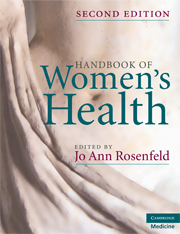Book contents
- Handbook of Women's Health
- Handbook of Women's Health
- Copyright page
- Dedication
- Contents
- Contributors
- Section 1 Introduction
- Section 2 Sexuality
- Section 3 Genitourinary concerns
- Chapter 10 Menstrual changes: amenorrhea, oligomenorrhea, polycystic ovary syndrome, and abnormal menstrual bleeding
- Chapter 11 Menstrual, urogynecological and vasomotor changes in perimenopause and menopause
- Chapter 12 Sexually transmitted diseases
- Chapter 13 Vaginitis
- Chapter 14 Chronic pelvic pain, dysmenorrhea, and dyspareunia
- Chapter 15 The Papanicolaou smear and cervical cancer
- Chapter 16 Postmenopausal bleeding and endometrial cancer
- Chapter 17 Ovarian cancer and masses
- Chapter 18 Urinary incontinence and infections
- Section 4 Breast disorders
- Section 5 Psychological concerns
- Section 6 Common medical problems
- Index
Chapter 18 - Urinary incontinence and infections
from Section 3 - Genitourinary concerns
Published online by Cambridge University Press: 26 December 2009
- Handbook of Women's Health
- Handbook of Women's Health
- Copyright page
- Dedication
- Contents
- Contributors
- Section 1 Introduction
- Section 2 Sexuality
- Section 3 Genitourinary concerns
- Chapter 10 Menstrual changes: amenorrhea, oligomenorrhea, polycystic ovary syndrome, and abnormal menstrual bleeding
- Chapter 11 Menstrual, urogynecological and vasomotor changes in perimenopause and menopause
- Chapter 12 Sexually transmitted diseases
- Chapter 13 Vaginitis
- Chapter 14 Chronic pelvic pain, dysmenorrhea, and dyspareunia
- Chapter 15 The Papanicolaou smear and cervical cancer
- Chapter 16 Postmenopausal bleeding and endometrial cancer
- Chapter 17 Ovarian cancer and masses
- Chapter 18 Urinary incontinence and infections
- Section 4 Breast disorders
- Section 5 Psychological concerns
- Section 6 Common medical problems
- Index
Summary
- Type
- Chapter
- Information
- Handbook of Women's Health , pp. 193 - 204Publisher: Cambridge University PressPrint publication year: 2009

